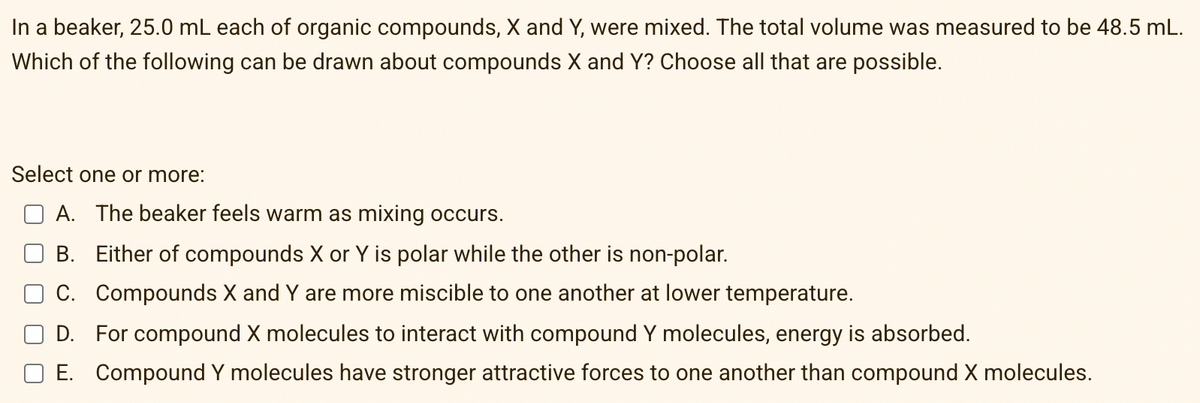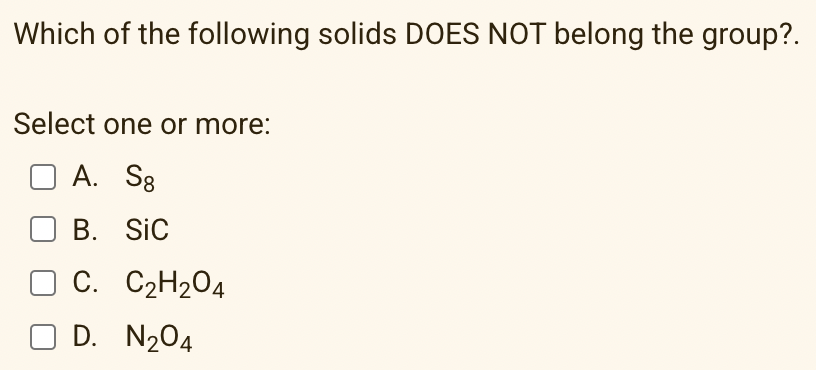In a beaker, 25.0 mL each of organic compounds, X and Y, were mixed. The total volume was measured to be 48.5 Which of the following can be drawn about compounds X and Y? Choose all that are possible. Select one or more: O A. The beaker feels warm as mixing occurs. B. Either of compounds X or Y is polar while the other is non-polar. O C. Compounds X and Y are more miscible to one another at lower temperature. D. For compound X molecules to interact with compound Y molecules, energy is absorbed. E. Compound Y molecules have stronger attractive forces to one another than compound X molecules. O O
In a beaker, 25.0 mL each of organic compounds, X and Y, were mixed. The total volume was measured to be 48.5 Which of the following can be drawn about compounds X and Y? Choose all that are possible. Select one or more: O A. The beaker feels warm as mixing occurs. B. Either of compounds X or Y is polar while the other is non-polar. O C. Compounds X and Y are more miscible to one another at lower temperature. D. For compound X molecules to interact with compound Y molecules, energy is absorbed. E. Compound Y molecules have stronger attractive forces to one another than compound X molecules. O O
Chemistry for Engineering Students
4th Edition
ISBN:9781337398909
Author:Lawrence S. Brown, Tom Holme
Publisher:Lawrence S. Brown, Tom Holme
Chapter8: Molecules And Materials
Section: Chapter Questions
Problem 8.29PAE
Related questions
Question
Kindly answer both. Thanks.

Transcribed Image Text:In a beaker, 25.0 mL each of organic compounds, X and Y, were mixed. The total volume was measured to be 48.5 mL.
Which of the following can be drawn about compounds X and Y? Choose all that are possible.
Select one or more:
A. The beaker feels warm as mixing occurs.
B. Either of compounds X or Y is polar while the other is non-polar.
C. Compounds X and Y are more miscible to one another at lower temperature.
D. For compound X molecules to interact with compound Y molecules, energy is absorbed.
E. Compound Y molecules have stronger attractive forces to one another than compound X molecules.

Transcribed Image Text:Which of the following solids DOES NOT belong the group?.
Select one or more:
A. S8
В. SiC
C. C2H204
D. N204
Expert Solution
This question has been solved!
Explore an expertly crafted, step-by-step solution for a thorough understanding of key concepts.
Step by step
Solved in 2 steps with 2 images

Knowledge Booster
Learn more about
Need a deep-dive on the concept behind this application? Look no further. Learn more about this topic, chemistry and related others by exploring similar questions and additional content below.Recommended textbooks for you

Chemistry for Engineering Students
Chemistry
ISBN:
9781337398909
Author:
Lawrence S. Brown, Tom Holme
Publisher:
Cengage Learning

Chemistry for Engineering Students
Chemistry
ISBN:
9781337398909
Author:
Lawrence S. Brown, Tom Holme
Publisher:
Cengage Learning